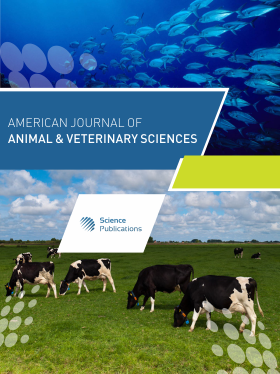Effects of Vitamin A on Growth Performance, Antioxidant Status and Blood Constituents in Lactating Grey Goat
- 1 Shandong Agricultural University, China
Abstract
Problem statement: It is regarded that vitamin A protects cells from damage by radicals which are believed to contribute to certain chronic diseases and regulates immune function of animals by protection of mucosal epithelium acting as the first defense barrier. All these properties of vitamin A may be attributable to its antioxidant activity. This study was to evaluate the effects of different levels of vitamin A on growth performance, antioxidant status and blood constituents of lactating ewes. Approach: Thirty-two multiparous lactating ewes of Grey goat (BW = 35.1 ± 1.1 kg) were divided into four groups of eight with four different supplementing levels of vitamin A (0, 2000, 3000 and 5000 IU kg−1 DM). Ewes were fed in individual lot at ad libitum intake and had free access to water. Average daily feed intake and average milk yield of ewes were measured weekly. Blood was obtained every 14 days to evaluate activities of antioxidant enzymes, blood constituents and vitamin A levels in serum. Results: In general, feed intake, milk yield and feed efficiency were not affected by vitamin A supplementation. However, supplementation of vitamin A increased (p<0.05) activities of glutathione peroxidase and total antioxidant capacity, but reduced (p<0.05) concentrations of malondialdehyde in serum of ewes. Red cells number increased linearly (p<0.01) and quadraticly (p<0.01) with incremental amount of vitamin A. Number of lymphocyte, concentration of hemoglobin and haematocrit were increased (p<0.05) by supplementing vitamin A. Serum retinol concentration was higher (p<0.05) for ewes supplemented with vitamin A at 5000 IU kg−1 than for control ewes, but retinol concentration in milk was not difference (p>0.05) among treatments. Conclusion/Recommendations: Addition of vitamin A improved antioxidant status of lactating Grey goat thereby enhanced their immune function. The optimum level of vitamin A supplementation for this purpose was between 2000 and 3000 IU kg−1 DM.
DOI: https://doi.org/10.3844/ajavsp.2010.274.281

- 4,328 Views
- 4,445 Downloads
- 3 Citations
Download
Keywords
- Lactating ewe
- growth performance
- antioxidant status
- blood metabolites
- High Performance Liquid Chromatography (HPLC)
- Total Superoxide Dismutase (T-SOD)
- Optical Density (OD)
- Malondialdehyde (MDA)
- ANOVA
- immune function
- hemoglobin
- lymphocyte
- glutathione peroxidase
